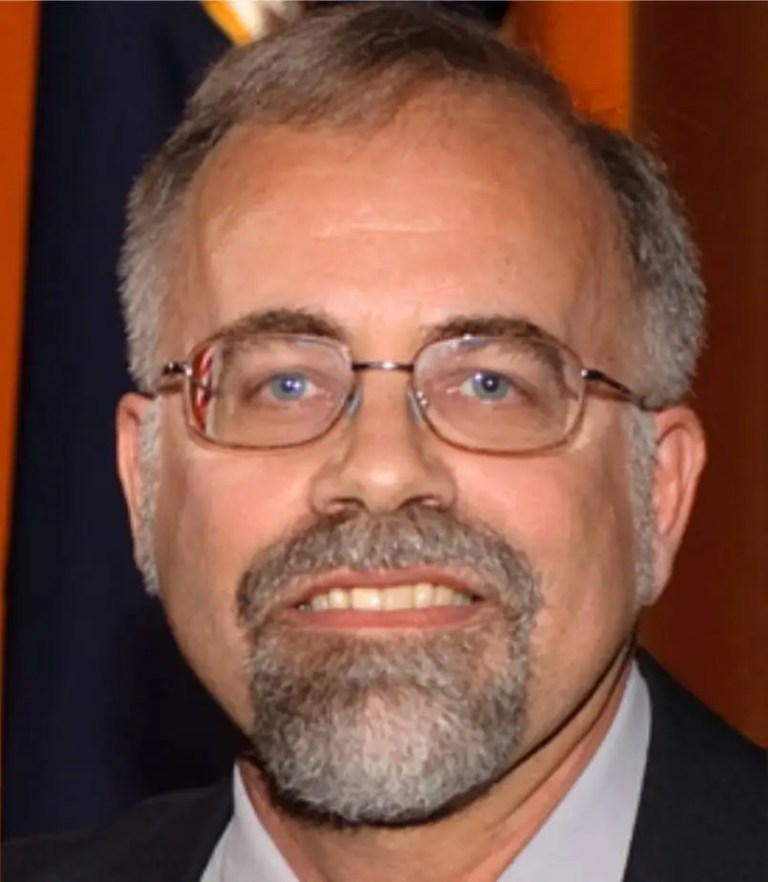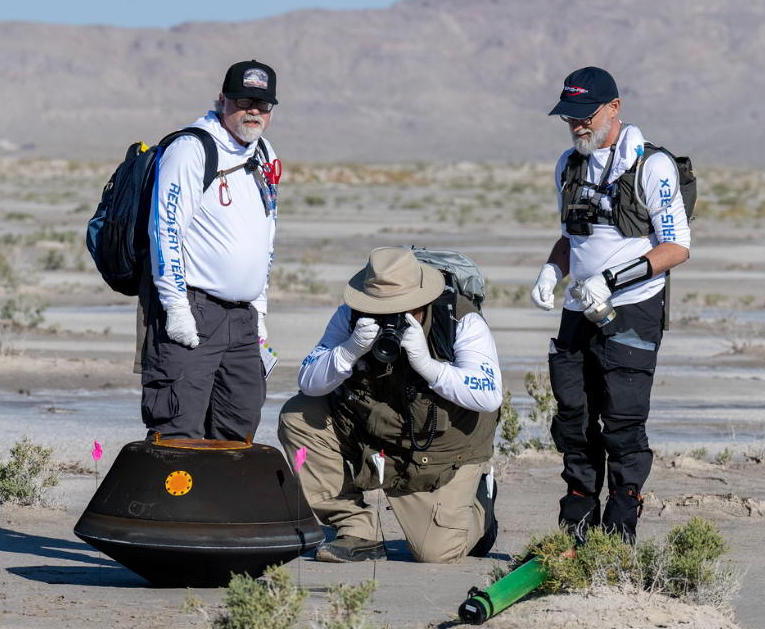
Scott Sandford
Senior Laboratory Astrophysicist
Affiliation: NASA Ames Research Center: Code S
Email: Scott.A.Sandford@nasa.gov
Phone: 650-279-9874
Read Scott Sandford‘s interview
Professional Biography
Dr. Sandford is a research scientist at NASA’s Ames Research Center, where he has now worked for over 38 years and is one of the leaders of Ames’ Astrochemistry and Astrophysics Laboratory. He grew up in the area around Los Alamos and Santa Fe in New Mexico and has pretty much always been surrounded by scientists. He graduated from Los Alamos High School in 1975 and earned BS degrees in Mathematics and Physics from the New Mexico Institute of Mining and Technology in 1978. He subsequently earned MA and PhD degrees in Physics from Washington University in St. Louis (1981 and 1985), where he studied meteorites and interplanetary dust particles collected from the upper atmosphere using NASA U2 aircraft. He has over 35 years of experience in the fields of meteoritics, is an Associate Editor of the journal Meteoritics and Planetary Science, and has helped find many meteorites in Antarctica working with the ANSMET Program.
Dr. Sandford also does extensive work in the areas of laboratory astrophysics, astrochemistry, and astrobiology, and participates in infrared astronomy studies using ground-based, airborne, and spaceborne observatories. He has used the combined techniques of infrared astronomy and laboratory studies to identify new molecular species in space, many of interest to astrobiology (for example, amino acids, nucleobases, and sugars), and determine how they are formed. Dr. Sandford was a Co-Investigator on the successful Stardust Discovery Mission, which returned collected samples from Comet Wild 2 to Earth on January 15, 2006. Dr. Sandford led part of the effort to study the returned samples. He was also a Co-Investigator on the joint Japanese-US Hayabusa Mission that brought back samples of asteroid Itokawa to Earth in June 2010 and he is currently a Co-Investigator on NASA’s OSIRIS-REx mission, which returned samples of asteroid Bennu to Earth on September 24, 2023. In recognition of his work on extraterrestrial materials, asteroid 16035 Sasandford was named for him in 2004.
Education
B.S. with highest honors in Mathematics and Physics, December 22, 1978
New Mexico Institute of Mining and Technology, Socorro, N.M. 87801
M.A. in Physics, May 22, 1981, Washington University, St. Louis, MO 63130
Ph.D. in Physics, December 22, 1985, Washington University, St. Louis, MO 63130
Research Interests
The study of extraterrestrial materials (especially organics) in meteorites, cosmic dust, and returned samples from comets and asteroids
Sample return missions
Laboratory astrochemistry/astrophysics/astrobiology
Abiotic synthesis of organic compounds in astrophysical environments
Infrared astronomy (particularly spectroscopy)
Select Publications
Dr. Sandford has authored and co-authored over 240 scientific papers in the peer-reviewed literature and currently has an H-index of 83. Selected peer-reviewed papers are provided below.
Yabuta, H., et al.(2023). Macromolecular organic matter in samples of the asteroid (162173) Ryugu. Science 379, 790 (13 pp).
Kaiser, K., Schulz, F., Maillard, J F., Hermann, F., Pozo, I., Peña, D., Cleaves II, H. J., Burton, A. S., Danger, G., Afonso, C., Sandford, S., & Gross, L. (2022). Visualization and identification of single meteoritic organic molecules by atomic force microscopy. Meteoritics and Planetary Science 57, 644-656.
Kaplan, H. H., et al. (2021). Composition of Organics on Asteroid (101955) Bennu. Astron. Astrophys. 653, L1.
Sandford, S. A. Nuevo, M., Bera, P. P., & Lee, T. J. (2020). Prebiotic Astrochemistry and the Formation of Molecules of Astrobiological Interest in Interstellar Clouds and Protostellar Disks. Chemical Reviews 120, 4616-4659; https://dx.doi.org/10.1021/acs.chemrev.9b00560
Nuevo, M., Cooper, G., & Sandford, S. A. (2018). Deoxyribose and deoxysugar derivatives from photoprocessed astrophysical ice analogues and comparison to meteorites. Nature Communications 9:5276, https://doi.org/10.1038/s41467-018-07693-x
Materese, C. K., Nuevo, M., & Sandford, S. A. (2017). The Formation of Nucleobases from the Ultraviolet Photoirradiation of Purine in Simple Astrophysical Ice Analogues. Astrobiology 17, #8, 761-770. DOI: 10.1089/ast.2016.1613
Materese, C. K., Cruikshank, D. P., Sandford, S. A., Imanaka, H., & Nuevo, M. (2015). Ice Chemistry on Outer Solar System Bodies: Electron Radiolysis of N2-, CH4-, and CO-containing ices. Astrophys. J. 812:150 (9 pp).
Sandford, S. A., Bera, P. P., Lee, T. J., Materese, C. K., & Nuevo, M. (2015). Photosynthesis and Photo-Stability of Nucleic Acids in Prebiotic Extraterrestrial Environments. Chapter 4 of Topics of Current Chemistry, Vol. 356, Photoinduced Phenomena in Nucleic Acids II, Mario Barbatti, Antonio C. Borin, Susanne Ullrich (eds.), (Springer-Verlag: Berlin, Heidelberg), pp. 123-164. DOI: 10.1007/128_2013_499; ISBN 978-3-319-13271-6
Nuevo, M., Materese, C. K., & Sandford, S. A. (2014). The Photochemistry of Pyrimidine in Realistic Astrophysical Ices and the Production of Nucleobases. Astrophys. J. 793, 125 (7pp).
Sandford, S. A., Bernstein, M. P., & Materese, C. K. (2013). The Infrared Spectra of Polycyclic Aromatic Hydrocarbons with Excess Peripheral H Atoms (Hn-PAHs) and their Relationship to the 3.4 and 6.9 µm PAH Emission Features. Astrophys. J. Suppl. Ser 205:8.
Ciesla, F. J., and Sandford, S. A. (2012). Organic Synthesis via Irradiation and Warming of Ice Grains in the Solar Nebula. Science 336, 452-454.
Nakamura, T., Noguchi, T., Tanaka, M., Zolensky, M. E., Kimura, M., Tsuchiyama, A., Nakato, A., Ogami, T., Ishida, H., Uesugi, M., Yada, T., Shirai, K., Fujimura, A., Okazaki, R., Sandford, S. A., Ishibashi, Y., Abe, M., Okada, T., Ueno, M., Mukai, T., Yoshikawa, M., & Kawaguchi, J. (2011). Itokawa dust particles: A Direct Link Between S-Type Asteroids and Ordinary Chondrites. Science 333, 1113-1116.
Nuevo, M., Milam, S. N., Sandford, S. A., De Gregorio, B. T., Cody G. D., & Kilcoyne, A. L. D. (2011). XANES analysis of organic residues produced from the UV irradiation of astrophysical ice analogs. Adv. Spa. Res. 48, 1126.
Cody, G., D., et al. (2008). Quantitative Organic and Light-Element Analysis of Comet 81P/Wild 2 Particles using C-, N-, and O- µ-XANES. Meteoritics and Planetary Science 43, 353-365.
Sandford, S. A. (2008). Terrestrial Analysis of the Organic Component of Comet Dust. Ann. Rev. Anal. Chem. 1, 549-578.
Sandford, S. A., et al. (2006). Organics Captured from Comet). Organics Captured from Comet 81P/Wild 2 by the Stardust Spacecraft. Science 314, 1720-1724.
Brownlee, et al. (2006). Comet 81P/Wild 2 Under a Microscope. Science 314, 1711-1716.
Bernstein, M. P., Dworkin, J. P., Sandford, S. A., Cooper, G. W., & Allamandola, L. J. (2002). Racemic Amino Acids from the Ultraviolet Photolysis of Interstellar Ice Analogues. Nature 416, 401-403.
Deamer, D., Dworkin, J. P., Sandford, S. A., Bernstein, M. P., & Allamandola, L. J. (2002). The First Cell Membranes. Astrobiology 2, #4, 371-381.
Dworkin, J. P., Deamer, D. W., Sandford, S. A., & Allamandola, L. J. (2001). Self-Assembling Amphiphilic Molecules: Synthesis in Simulated Interstellar/Precometary Ices. Proc. Nat. Acad. Sci. USA 98, 815-819.
Sandford, S. A., Bernstein, M. P., & Dworkin, J. P. (2001). Assessment of the interstellar processes leading to deuterium enrichment in meteoritic organics. Meteoritics and Planetary Science 36, 1117-1133.
Bernstein, M. P., Sandford, S. A., Allamandola, L. J., Gillette, J. S., Clemett, S. J., & Zare, R. N. (1999). UV Irradiation of Polycyclic Aromatic Hydrocarbons in Ices: Production of Alcohols, Quinones, and Ethers. Science 283, 1135-1138.
Sandford, S. A. (1996). The Inventory of Interstellar Materials Available for the Formation of the Solar System. Meteoritics and Planetary Science 31, 449-476.
Sandford, S. A., Pendleton, Y. J., & Allamandola, L. J. (1995). The Galactic Distribution of Aliphatic Hydrocarbons in the Diffuse Interstellar Medium. Astrophys. J. 440, 697-705.
Sandford, S. A., Allamandola, L. J., Tielens, A. G. G. M., Sellgren, K., Tapia, M., & Pendleton, Y. (1991). The Interstellar C-H Stretching Band near 3.4 µm: Constraints on the Composition of Organic Material in the Diffuse Interstellar Medium. Astrophys. J. 371, 607-620.
Sandford, S. A., Allamandola, L. J., Tielens, A. G. G. M., & Valero, G. (1988). Laboratory studies of the infrared spectral properties of CO in astrophysical ices. Astrophys. J. 329, 498-510.
Sandford, S. A. (1986). Acid dissolution experiments: Carbonates and the 6.8 micron bands in interplanetary dust particles. Science 231, 1540-1541.
Sandford, S. A., & Walker, R. M. (1985). Laboratory infrared transmission spectra of individual interplanetary dust particles from 2.5 to 25 microns. Astrophys. J. 291, 838-851.
Sandford, S. A. (1984). Infrared transmission spectra from 2.5 to 25 microns of various meteorite classes. Icarus 60, 115-126.
Select Accepted Proposals
“The Formation and Evolution of Prebiotic Organics in Extraterrestrial Environments: Exploring the Role of Astrochemistry in the Origin of Life”, (PI), NASA Interdisciplinary Consortia for Astrobiology Research (NNH22ZDA001N-ICAR), Funding – $4,358,186 over 5 years
NASA Missions
NASA Stardust comet sample return mission to Comet Wild2
JAXA Hayabusa asteroid sample return mission to Asteroid Itokawa
JAXA Hayabusa2 asteroid sample return mission to Asteroid Ryugu
NASA OSIRIS-REx asteroid sample return mission to Asteroid Bennu
Numerous flights on the Kuiper Airborne Observatory (KAO) and Stratospheric Observatory for Infrared Astronomy (SOFIA).
Awards & Others
Multiple Group Achievement awards including: NASA Hayabusa2 Team-2023; Stardust Interstellar Preliminary Examination Team – 2013; Hayabusa Sample Transport and Curation Team – 2013; Hayabusa Re-entry Airborne Observation Team – 2010; SMEX Proposal Teams – 2008; Stardust Recovery Team – 2007; Stardust Flight Team – 2005; The Astrochemistry Laboratory – 2002; Stardust Project Team – 2000; NASA Astrobiology Team – 2000
Team Recipient – 2022 Swigert Award for Space Exploration (for OSIRIS-REx Mission) (2022)
International Academy of Astronautics, Laurels for Team Achievement (for Hayabusa) (2011)
Named a Fellow of the American Physical Society (2010)
Multiple NASA/Ames Scientist/Researcher/Special Achievements Honor Awards (2010, 2006, 1998, 1997, 1996, 1993,1989, 1988)
NASA Exceptional Scientific Achievement Medal (2009)
H. Julian Allen Award (with M. Bernstein, L. Allamandola, and R. Zare) (2007)
Air Force Association Honor Award (2007)
Astronomical Association of Northern California (AANC) Award for Outstanding and Continuous Support in Distinguishing and Fostering Amateur Astronomy (2006)
Named a Fellow of the Meteoritical Society (2006)
Stardust Outstanding Achievement Award (2004)
Asteroid 16035 named 16035 Sasandford (2004)
Named an Ames Associate Fellow (5/18/00)
Awarded the Antarctic Service Medal (for work done with ANSMET)
Websites
http://www.astrochemistry.org/
























